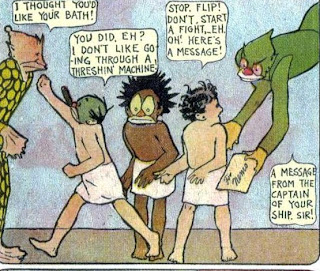Later in life, Robert Heinlein (1907-1988) was well known as the cranky, conservative, racist, sexist "old man" of science fiction, who wrote weird, turgid, overlong, and heterosexist novels, but between 1948 and 1963, he produced 18 juveniles, about teenage boys involved in interstellar intrigue, with same-sex bonds often intense and intimate, and hardly any heterosexual dating or romance.
Tunnel in the Sky (1955) was my favorite, perhaps because its protagonist, Rod, never displays the slightest interest in a girl.
The plot: for a high school class in this rip-roaring frontier future. Rod and hundreds of other students are zapped through a space-portal to an alien planet for survival training: "any climate, any terrain.”
They find themselves in a tropical paradise, plagued only by bloodthirsty carnivorous rabbits.
The ten days of the test pass, and then twenty, and thirty, and no time-space portal opens to zap them home. But the castaways don't devolve into
Lord of the Flies savagery; they build a no-nonsense libertarian community, Cowperstown, with farming and metallurgy and square dances every weekend. Rod is elected mayor.
Not much of gay interest so far: in fact, the first thing on everyone’s mind is marriage and children. A former pre-law student even puts out a shingle as a divorce lawyer.
But, oddly, Rod fails to marry, or date, or even flirt. When challenged, he protests that he does indeed like girls, but heterosexual romance would compromise his effectiveness as a political leader.
Such an argument makes little sense, and is based on no real life model; in fact, few men are ever elected to high political office without sporting a wife on their arm. Perhaps Rod comes up with this lame excuse to hide his actual lack of interest in girls.
Early in the survival test, Rod briefly teams up with Jack, a student from another school. They hunt, cook, and seek shelter together, and develop a chummy friendship until Rod discovers that Jack is really Jacqueline, a girl!
It is unclear why she would need to hide her gender, since girls and boys both participate in the test. But the girl pretending to be a boy is a standard plot device. A male friend finds “him” attractive and has a bout of homophobic panic. Then he discovers that “he” is really a “she,” that is instincts were right all along, thereby “proving” that heterosexual desire is innate and natural, foolproof even when the object is disguised.
Rod, however, does not feel confused or conflicted about his feelings for Jack. When he discovers that Jack is a girl, he is surprised but not relieved, and the two do not subsequently begin a romance. Instead, he has to defend himself from the jeers of his friends, who claim that they are so competent at their heterosexuality that they realized right away that Jack was a girl.
Eventually the rescue portal opens, but even then, Rod does not return home to a heteronormative future. Cowperstown is home, and he is staying put.
Heinlein no doubt omitted hetero-romance from his novels because he believed his target audience of teenage boys would not be interested. But the gay boys who stumbled upon them twenty years later found a strong validation of the legitimacy of "not liking girls."
































